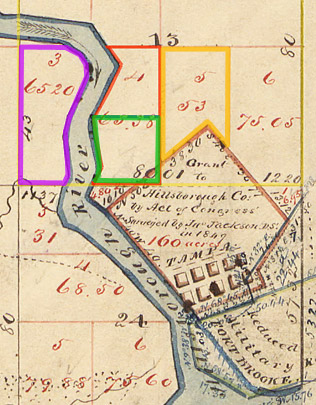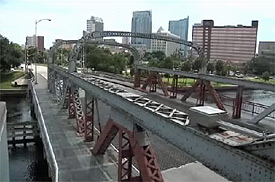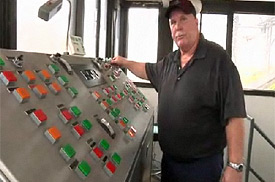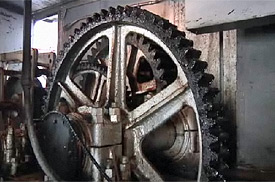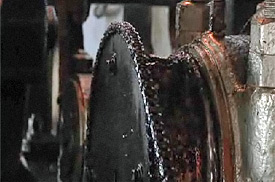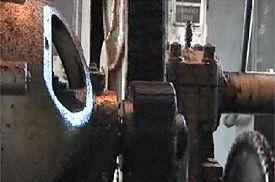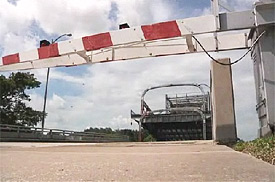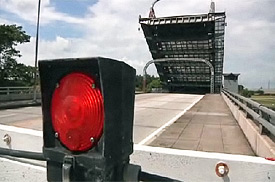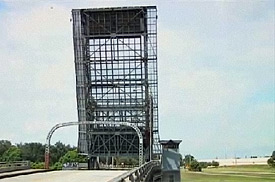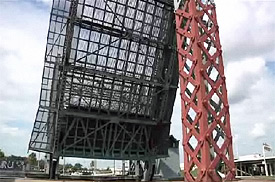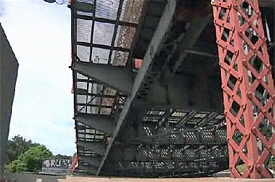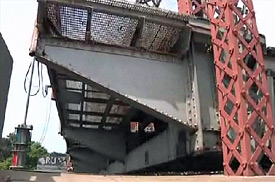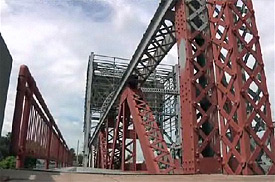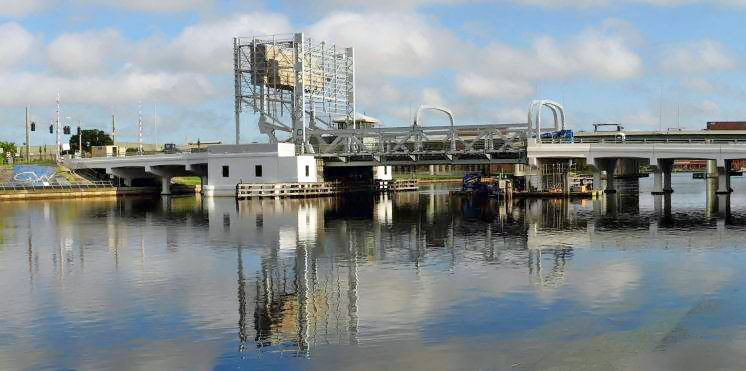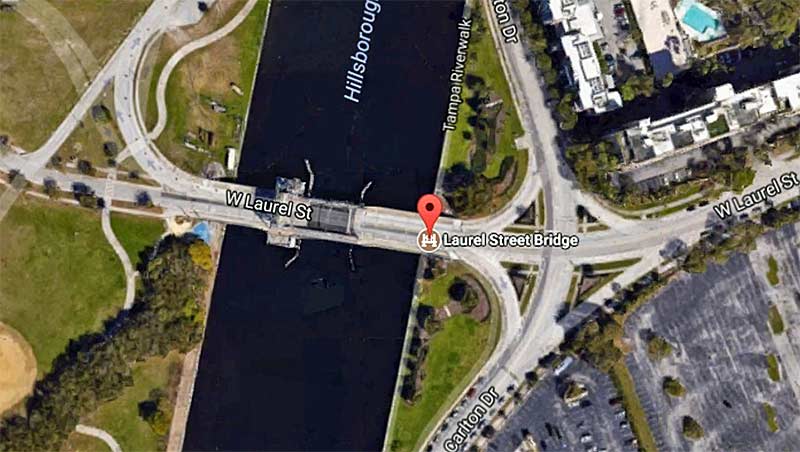|
WHAT'S
IN A NAME? - Page 2 - FORTUNE STREET & BRIDGE (a.k.a. The Laurel Street Bridge)
|
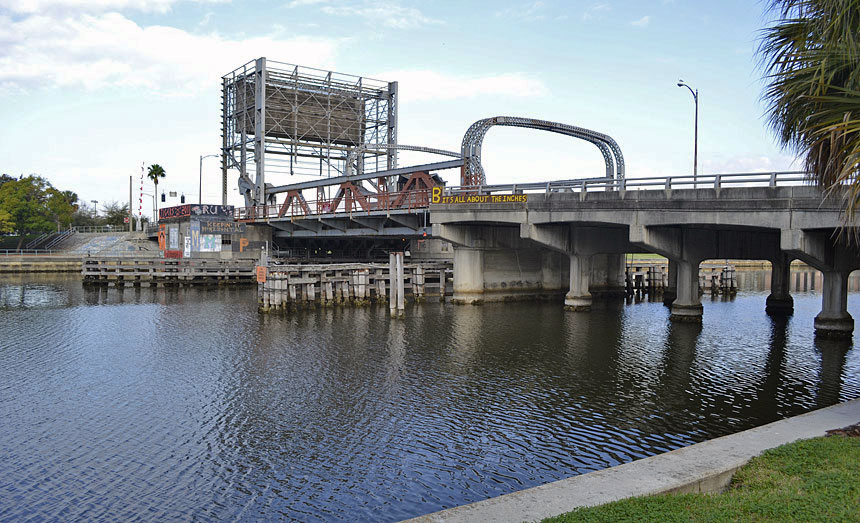 |
|
Completed in 1927 by UGI Contracting Company of Philadelphia
as the Fortune Street Bridge, it is the second
bridge across the Hillsborough River at this
location. Now named the Laurel Street bridge,
it is a
pony
truss single-leaf
trunnion bascule bridge; using a large counterweight which
is lowered to lift the end of a large metal arm that
supports the roadway (leaf.) This type of bridge was
more often used for railroads rather than vehicles. It
has a total length of about 366 feet with the largest span
being nearly 100 feet long, with a deck width of 40 feet.
The bridge was rehabilitated in 1969. [Photos
taken Feb. 26, 2011]
Hillsborough County Bridge Inspection Data |
Fortune Street and Bridge Namesake
Fortune Street downtown and the Fortune Street
Bridge (now named the Laurel St. Bridge) across the
Hillsborough River, were named for Fortune Taylor,
a former slave and wife of former Hernando County
slave, Benjamin Taylor. Together, the Taylors
tended orchards of oranges, guavas, and peaches on
the eastern shore of the Hillsborough River in the
late 1800s. After Benjamin's death in 1869,
Fortune was granted homestead to their 33 acres
along the east bank of the Hillsborough River, on
July 1, 1875. Three years later, Tampa mayor Edward
A. Clarke bought some of her land for $252. |
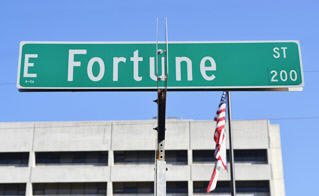 |
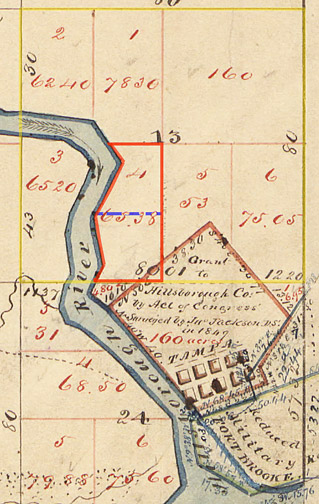
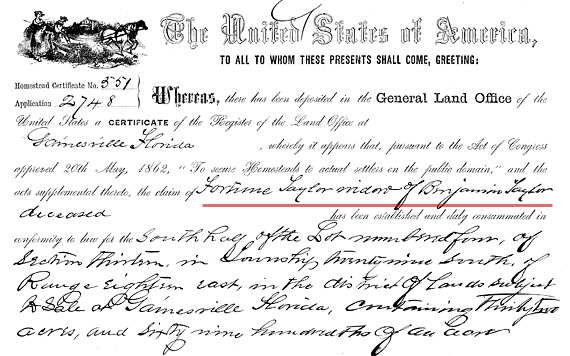 |
|
Above,
Fortune Taylor's homestead claim document. She
is "Fortune Taylor widow of Benjamin Taylor
deceased." Her property is the south half of
lot numbered four, of section 13, in township 29
south, range 18 east. Below, the lower
half of the same document, dated 1st day of July,
1875, by President U.S. Grant. |
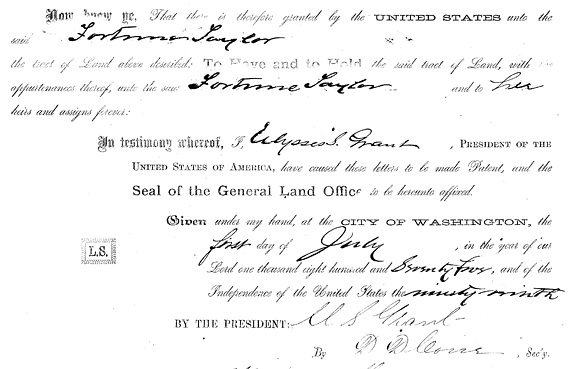 |
|
At left: Close up of
Fortune Taylor's 32.69 acre property today, outlined
in green. It included land from the riverbank,
eastward to Tampa Street, and southward almost to
today's intersection of Tampa Street and Tyler.
Wall Street Becomes Fortune Street
Thomas and Ellen Jackson were also freed persons
living just north of Tampa, which today is the
northern part of downtown. In 1871, the
Jacksons sold eight acres of their homestead to
Bartholomew Leonardi, a Reconstruction-era
Republican.
Leonardi resold this property as home sites for
African Americans. The development included new
streets, one of which Leonardi named in honor of
Judge Perry G. Wall. Soon, however, Wall Street
became Fortune Street, since the road led to
Taylor’s homestead on the river.
|
|
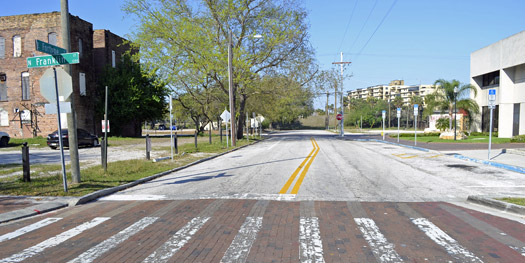
|
|
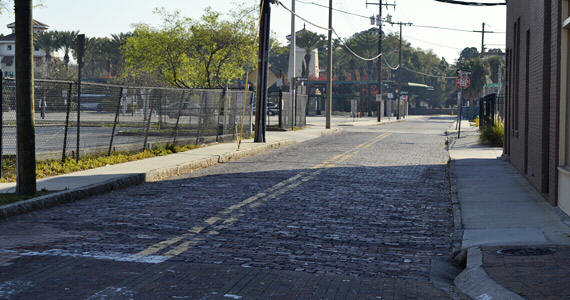 |
|

|
|
In 1885,
Florida took a state census. Ned &
Fortune Ranson were listed in Tampa. Ned was 35*, born
in Georgia, and worked as a mill watchman.
Fortune was 60, putting her birth year at about
1825. She was born in South Carolina and her
parents were born in Virginia. *Ned's age may be
fairly accurate. The 1880 census of Waresboro,
GA, shows a Ned Ranson who may be the same person.
He was age 33, widower, and working at a sawmill. |
|
Place your
cursor on the map above to see this area today. The
above map shows a portion of an 1852 survey of Hillsborough
County. For the purpose of this article, the large
yellow border has been added to mark section 13 of Township 29
south, Range 18 east. Original survey markings indicate
lots 1 through 6 with the acreage also marked. Lot 4 was
65.38 acres, marked by a red border which has been added.
The added blue line divides lot 4 into a north and south half,
of which Fortune Taylor was granted the south half. Note the
bottom right corner shows "Reduced Military Fort Brooke."
Above it, the area surveyed by John Jackson which became
downtown Tampa.
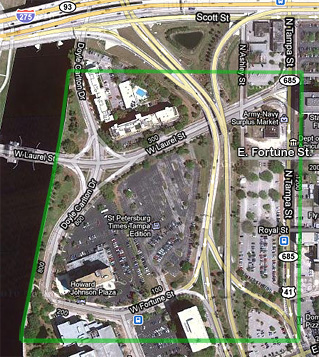
At right: All
that remains of the original Fortune Street today,
westward from Franklin Street looking toward the
end at the Ashley St. exit ramp.
In the 1960s, the
I-275 exit ramps at Ashley St. severed Fortune Street's
path to the river.
At right: Fortune
Street today, looking east from
Franklin St. The stop sign at the right is Tampa St.,
where Fortune's property ended and
where Thomas Jackson's homestead began and extended to Oaklawn Cemetery,
seen at the wall in the distance.
"Madam Fortune" Taylor Ranson
By 1885, Fortune Taylor had married
Ned Ranson but everyone knew her as "Madame Fortune" or "Aunt
Fortune," a successful businesswoman who sold baked goods.
She left Tampa for a few years, but by the 1890s she returned
and worked as a maid for Mayor Ed Clarke’s widow, Sarah.
Fortune was remembered by Dr. Robert W. Saunders Sr.'s mother
as a “short, stout woman." She was especially loved by
children. On the streets, she gave peanuts and pies to the
poor neighborhood children. "She lived in one of the
houses with the slabs up and down. My mother says that she
asked my grandmother, why did Madame Fortune live in this
house when she was rich? Of course, thinking she
was rich
because of the Fortune Street Bridge."
|
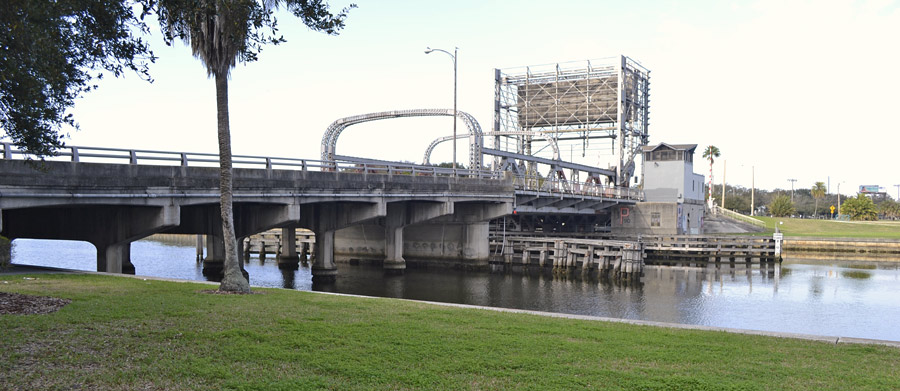
The north
side of the Laurel Street bridge, as seen from the
downtown end (east bank of Hillsborough River) |
|
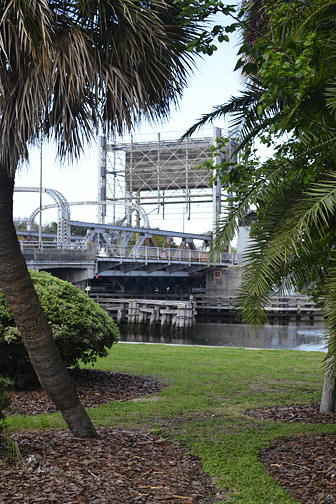 |
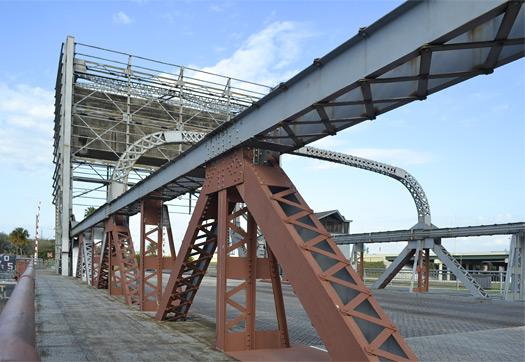 |
|
 |
Hooper's Ferry
On June 15, 1877, Matthew
Hooper--a northerner, and county commissioner--claimed a
65 acre homestead in Lot 3 of Section, 13, on the west
side of the river, opposite the Taylor’s place. Here his
son Jim ran a dairy and grew oranges. In the early 1900s,
this area was known as Roberts City.
The Hoopers worked with
Scottish businessman
Hugh Macfarlane to create a new cigar factory town
across the river from Tampa. Macfarlane accumulated
acreage and investors, and in 1892, the development of
West Tampa got underway.
The only way across the
river to West Tampa was on Jim Hooper’s ferry, which was
just a small boat or skiff. The ferryman would pull
passengers and goods across the river in his boat using a
rope strung across the river. This mode of transportation
did nothing to promote West Tampa, and soon the only cigar
factory in town was sinking into bankruptcy. Macfarlane
tried to convince other factory owners to come to this new
town, but the lack of a bridge made West Tampa a hard
thing to sell.
At that time Tampa had
only two bridges over the Hillsborough River, and one of
those belonged to the railroad company, which was at Cass
Street, It had a wooden footpath, but the swaying and shaking
kept many people from using it. Another bridge, further
south at Lafayette Street, connected Hyde Park and
downtown, but there were no paved roads between Hyde Park
and West Tampa until the 1910s.
In
September 1892, Jones & Cooper (acting for Macfarlane),
along with L.B. Skinner, petitioned the city council for
permission to build a bridge over the Hillsborough River,
connecting Fortune Street to the east and Arch Street to
the west. This bridge was to be strong enough to carry a
fifteen-ton load, and be wide enough for both streetcars
and vehicles. Passage over the bridge would always be
free, without expense to the City of Tampa, although the
right to charge street railways or omnibus lines was
reserved. Macfarlane and his fellow West Tampa investors
were able to persuade the Tampa city council to let them
build a privately-financed bridge over the Hillsborough
River and the petition was granted. Developers
immediately began advertising land for sale on the west
side of the river, near the new bridge. Since a street
railway would run over the bridge to West Tampa, these
developers anticipated that more cigar factories would
locate in West Tampa once the bridge opened. The
commercial-civic elite saw the bridge, paid for with
private funds, as a good business strategy, and supporting
the city’s economy was equivalent to good citizenship.
In October 1892, the American Bridge
Company of Roanoke, Virginia, began construction of the
Fortune Street Bridge, a 500-foot long, 88-foot wide
swing span bridge completed in less than three months.
With the bridge in place, many factories were built in
West Tampa, and Macfarlane’s project was a success.
|
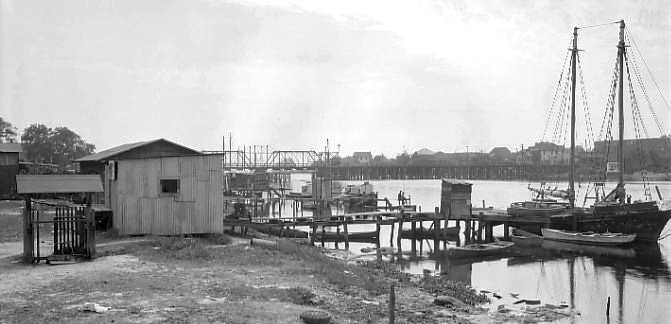 |
|
Looking downriver from Mirabella's fish company dock, a
view of the north side of the Fortune St. Bridge, 1924
Burgert Bros. photo from the Tampa-Hillsborough Co. Public
Library |
|
|
 |
|
This photo shows
the old 1892 bridge in the process of being
dismantled. Notice the swing span section at
right, in open position. A bridge tender
opened the bridge by turning a hand-held metal crank,
walking in circles to turn the gears that
opened the bridge. This was a fascinating spectacle
for local boys, but wearisome for workers wanting to
go home after a
day of rolling cigars. |
|
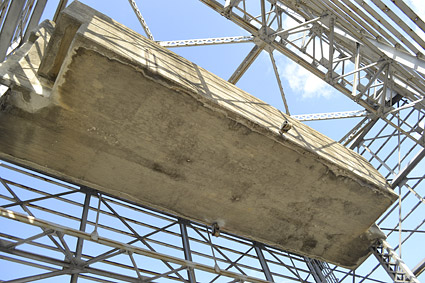 |
 |
|
Look up--the
part you hate to drive under. |
Look down--the
part you hate to drive on. |
| |
|
| .
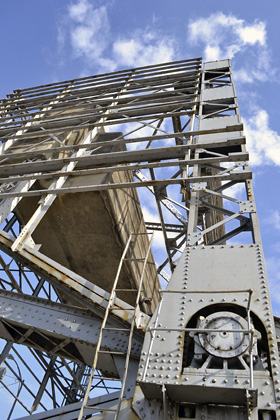
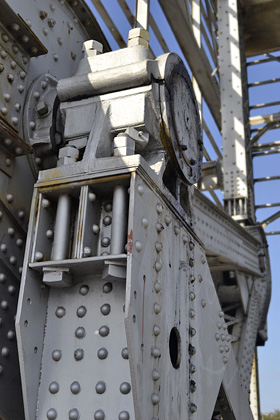
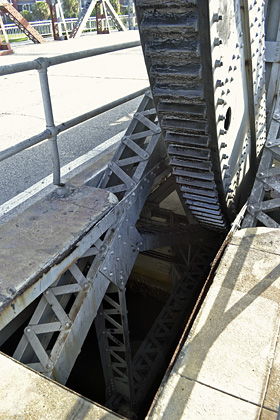 |
|
Close ups of
the axis (trunnion) where the counterweight and
draw span pivot and the drive gear on the draw
span |
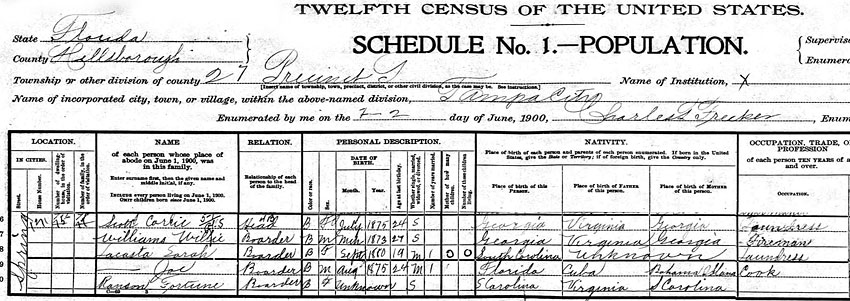 |
|
On the 1900
census in Tampa, Fortune Ranson was living in a
small boarding house with other apparently unrelated
persons on Spring Street. This was close to
Fortune Street, which was the next street enumerated
on this page. Fortune's age is shown as
"unknown" and her marital status is single.
She may have been away at the time the enumerator
visited and someone else in the house gave the info
about her. |
|
Bridge Accident Causes Cigar Makers Strike
As West Tampa grew,
the Fortune Street Bridge quickly became a victim
of its own success. The bridge closed for repairs
every few months because of repeated openings and
closings, rickety streetcar crossings, and
numerous boat collisions. In May 1901, a tugboat
knocked the Fortune Street Bridge off its
foundation. The bridge was open when the boat hit
it, and the resulting mechanical damage was enough
to freeze the swing span in the open position.
Travelers between West Tampa and Ybor City or
Tampa were forced to cross the river in rowboats.
Many female cigar factory workers refused to use
the boats after some passengers fell overboard.
However, the dangerously overcrowded rowboats
remained.
On May 15, 1901 workers who were reprimanded for
being late for work voiced grievances which soon
turned into a strike of 6,000 workers and a march by over 500
workers across the railroad bridge into Ybor City.
By the time they reached Palmetto Beach, the
crowd, which numbered 2,000, demanded a better
bridge into West Tampa. The city quickly built a
pontoon bridge for everyone to use until the
Fortune Street span was repaired, ending that
particular strike.
Labor issues, war, and other
demands on public funds delayed construction of a new bridge
at Fortune Street for more than two decades after that strike.
However, the 1920s brought prosperity and growth to Tampa, and
the city went went into a bridge-building frenzy. Real estate was
once more a hot
investment, and large tracts of land were available on the west
side of the river. |
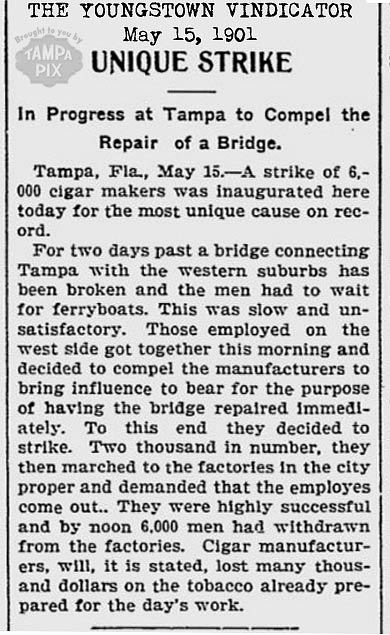 |
| |
Article from the Youngstown Vindicator,
Ohio |
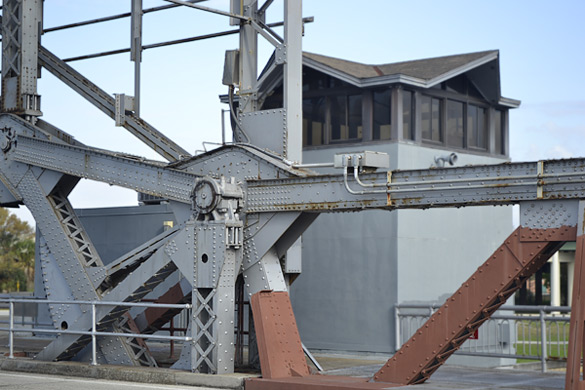
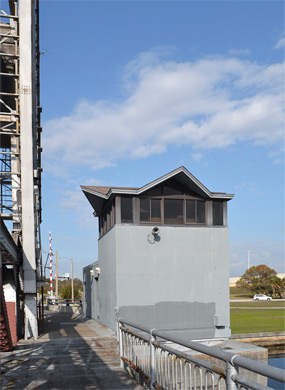
The bridge-tender house and the trunnion where the
counterweight pivots. In photo above, top left,
you can see the beam that pushes down from the overhead
counterweight (out of frame.) At lower left, the
curved gears that are driven by the motor under the
bridge. The the driving action of the motor on the
gears causes the counterweight assembly to lower and
whole assembly to rotate round the trunnion, thus
causing the truss which supports the roadway to the
right of the trunnion to raise up (like a see-saw.)
See this illustrated in the
photo below by placing your cursor over it.
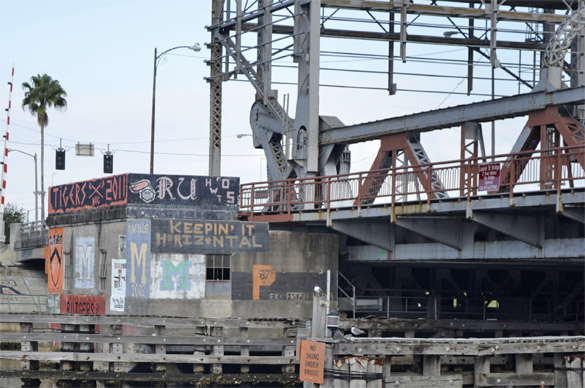
Rowers have left
their mark on the motor house, see "Rowers
Are Great Artists, Too."
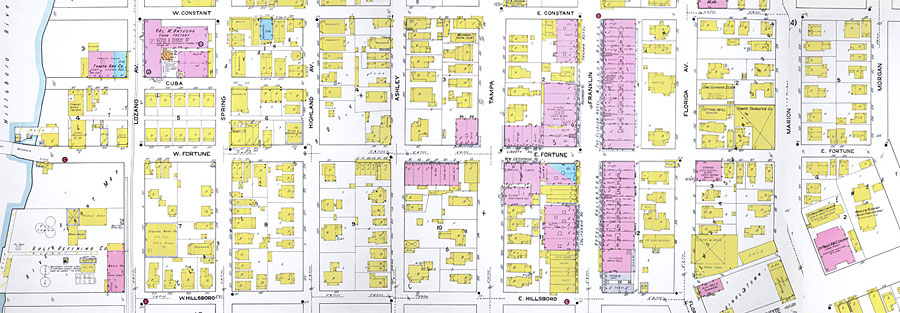 |
|
This 1915 map shows
the complete length of Fortune Street, with Oaklawn
Cemetery on the east end. Streets west of
Tampa Street (Ashley, Highland, Spring and Lozano) were wiped out
in the 1960s by the I-275 downtown exit and
subsequent development. The larger,
pink building at upper left between Lozano,
Constant, Spring & Cuba streets was the Val. M. Antuono cigar factory. This area was known as
"Little Havana." Constant St. became Laurel
Street and at the bottom, Hillsboro became Royal St.
Place your cursor on the image to see the area today
and how the bridge was connected to Laurel St.,
north of Fortune St. |
In 1924, Tampa voters approved
$3 million in public improvement projects, including several
new routes over the river. By January 1927, four Hillsborough
River bridges were in various stages of completion: a new
bridge at Michigan Avenue (now Columbus Avenue), a new bridge
at Florida Avenue, a replacement bridge at Fortune Street, and
a new bridge at Sligh Avenue that used the old iron from the
Fortune Street Bridge. UGI Contracting Company of Philadelphia
built the second Fortune Street Bridge, a
trunnion bascule, with a large weight dropping to lift the
end of a large metal arm. This was, and still is, an unusual
type of bridge for automobiles, being more commonly used for
trains. The new Fortune Street Bridge opened at midnight, May
14, 1927. No public ceremony marked the event, although some
boats blew their whistles at the flag-festooned bridge. This
was the last of the bridges built over the Hillsborough River
in the 1920s, with a final cost of $402,000.
|
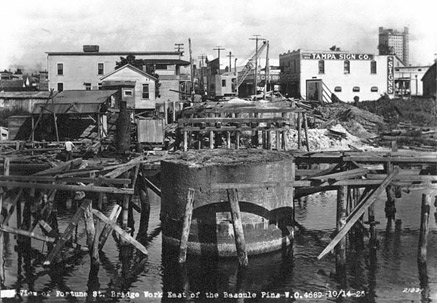 |
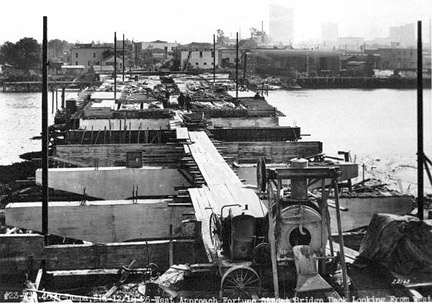 |
|
Last remains of
the old 1892 bridge, the piling that the pivot of
the swing span rested on. Burgert Bros. photo from
the Tampa-Hillsborough Co. Public Library |
Construction on
the concrete T-trusses for the new bridge, 1926
Burgert Bros. photo from the Tampa-Hillsborough Co.
Public Library |
| |
|
|
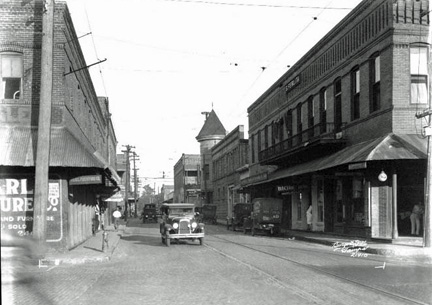 |
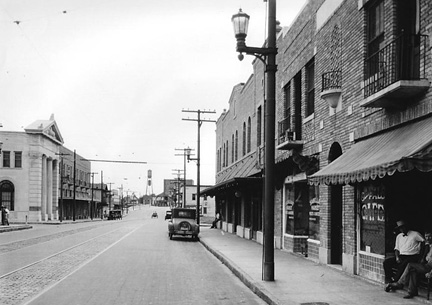 |
|
The 200 block of
Fortune Street, looking east, Oct. 1926
Burgert Bros. photo from the Tampa-Hillsborough Co.
Public Library |
The 200
block of Fortune Street, looking west to bridge,
1928
Burgert Bros. photo from the Tampa-Hillsborough Co.
Public Library |
| |
|
|
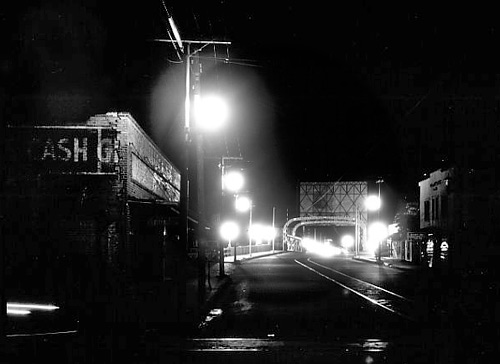 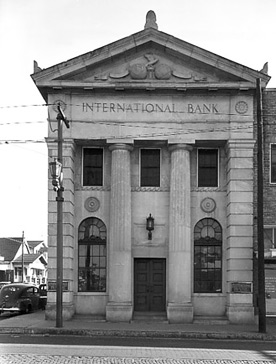 |
|
Fortune St. Bridge
approach from the west, 1935 |
International
Bank at 300 W. Fortune St., 1946 |
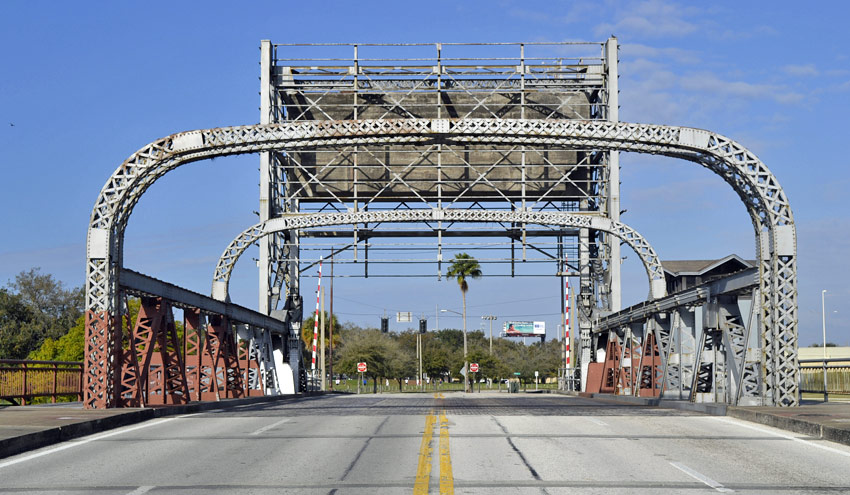
In its early days, Fortune
Street lived up to its name, being a valuable commercial
connection between West Tampa and the Franklin Street business
district in downtown Tampa. By 1967, its fortune had reversed.
A Tribune reporter described Fortune Street as being “in the
midst of Tampa’s Skid row, with the city’s only tattoo shop,
three bars, a mission, a barber shop, and a couple of
less-than-first-class hotels….” The street was also now quite
short, only eight blocks or so, the result of interstate
highway construction and urban renewal. Tampa’s urban renewal
projects also rerouted and renamed streets, and so the bridge
became the Laurel Street Bridge. The bridge underwent major
renovations in 1969, when glass towers replaced the original
wooden bridge tender houses. New plain concrete parapets and
tubular metal handrails reflected the stark modernism of the
times.
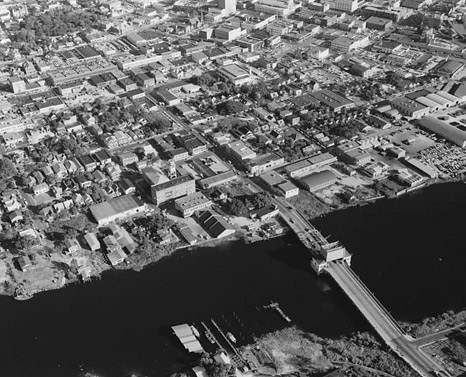
Although her name has been
erased from the bridge, Taylor is still recognized on a short
sliver of roadway known as Fortune Street between Doyle
Carlton and North Ashley drives. In Feb. of 2010, Fred
Hearns tried to get the city of Tampa to change the name of
the bridge back to the Fortune Street Bridge, but the City
would not, claiming that a bridge with such a name but
connecting on each end to Laurel Street would be confusing.
See:
Man Wants Name Change for Laurel Street Bridge and
A Historic Tour Through Tampa Trivia
Information from
"The Bridge of Fortune in Tampa", by
Lucy Jones, Tampa's Cigar City Magazine and
2002 interview of Dr. Robert W. Saunders, Sr. by Dr.
Canter Brown,
Bridgetender.com, and various newspaper articles.
Fortune
St. Bridge and a view of Fortune Taylor's former property
on the east bank of the Hillsborough River, 1957
Burgert Bros. photo from the Tampa-Hillsborough Co. Public
Library
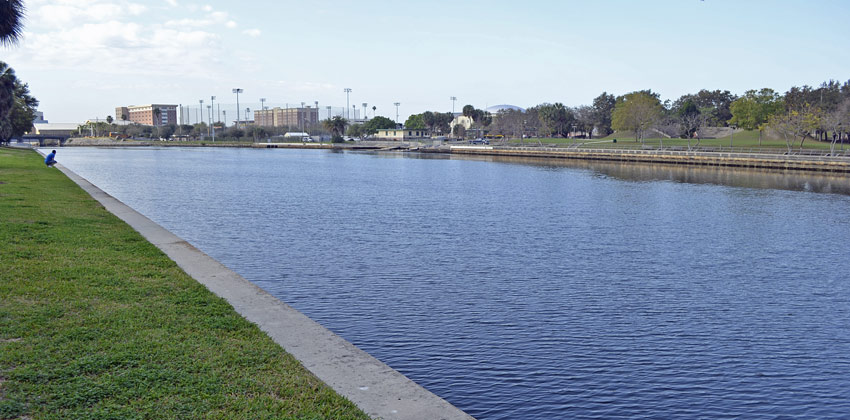
A view of the Hillsborough River looking
south from the Laurel St. bridge
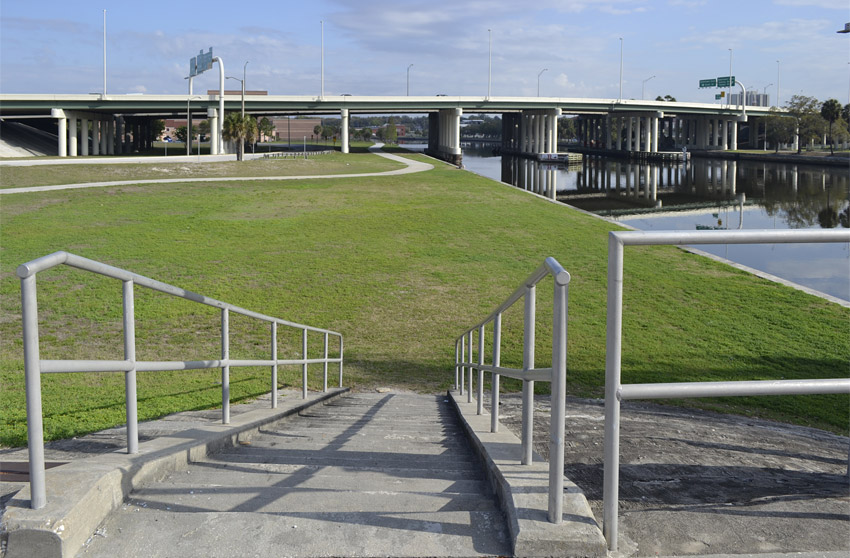
A view of Interstate 275 looking north from
the west end of the Laurel St. bridge
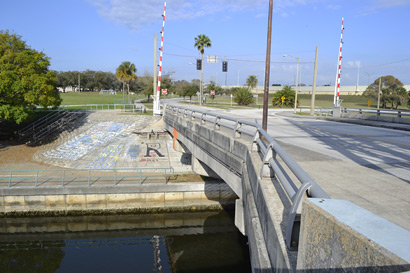
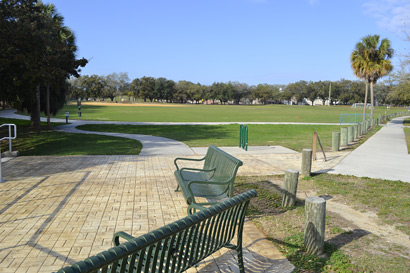
The west end of the
bridge at the Boys and Girls Clubs of America soccer field
In the 1890s, this area was known as Ellinger City, then
in the early 1900s, Roberts City and part of West Tampa.
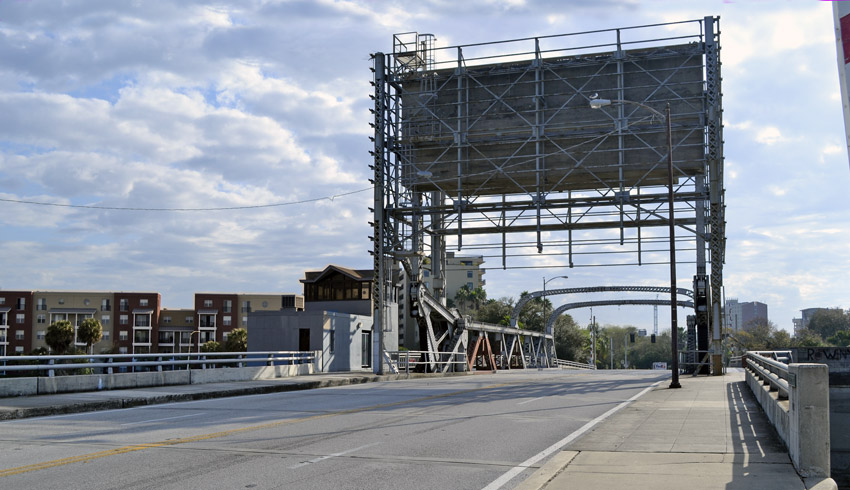
A view looking east
towards downtown
See inside the
bridge control room and watch the Laurel St. Bridge in
operation in the video below.
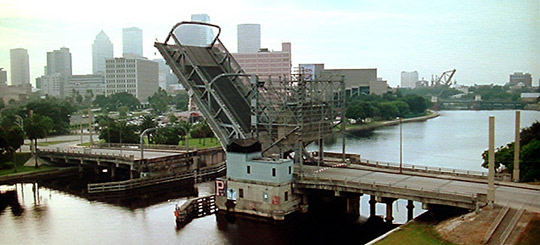
In 2003, film crews
spent three months in Tampa filming "The
Punisher," a high-profile Hollywood production made
entirely in the Tampa Bay area. For one scene, the
bridge-tender was directed to raise the Laurel Street Bridge
to a 15-degree incline to accommodate a car chase in which a
car sped over the partially open span. Cameras capturing the
moment included some affixed to the underside of the bridge.
|
As Frank Castle waits at the west side of the bridge
for the draw bridge to lower, hit man Harry Heck
approaches from behind. Castle sees him and
speeds through the barricade to the draw span.
There they collide and Heck commences shooting at
Castle's car. The draw span having lowered
considerably, Castle floors it as Heck continues
shooting. Castle's car speeds off the end of
the draw span when it's at a 15 degree incline,
crashing through the barricade on the other side,
and on to their final encounter.
See the
scene filmed in the Goody Goody Restaurant. |
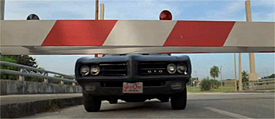 |
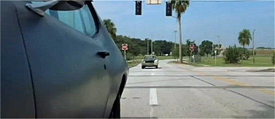 |
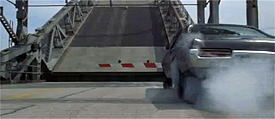 |
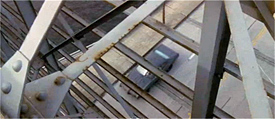 |
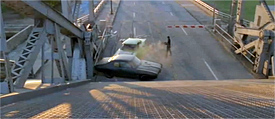 |
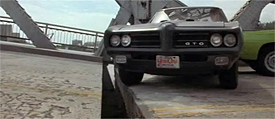 |
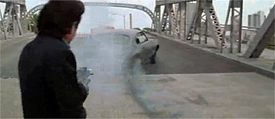 |
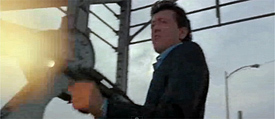 |
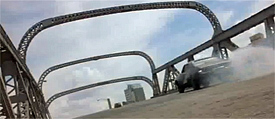 |
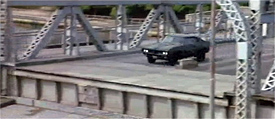 |
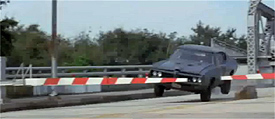 |
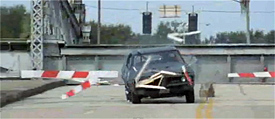 |
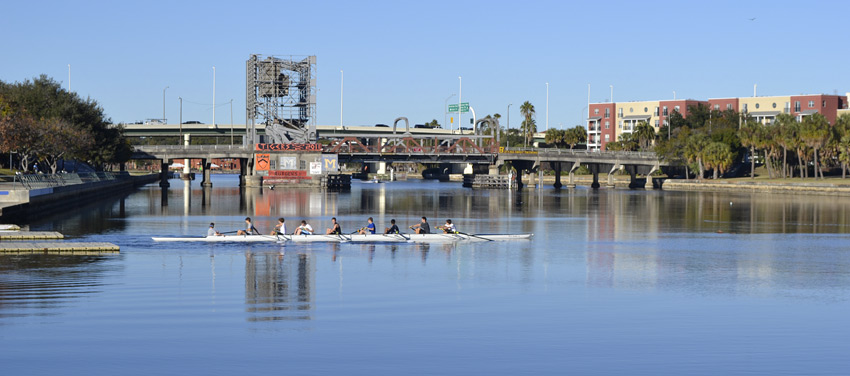
The Laurel Street bridge
and I-275 beyond it, as seen from Julian B. Lane Park
See full size
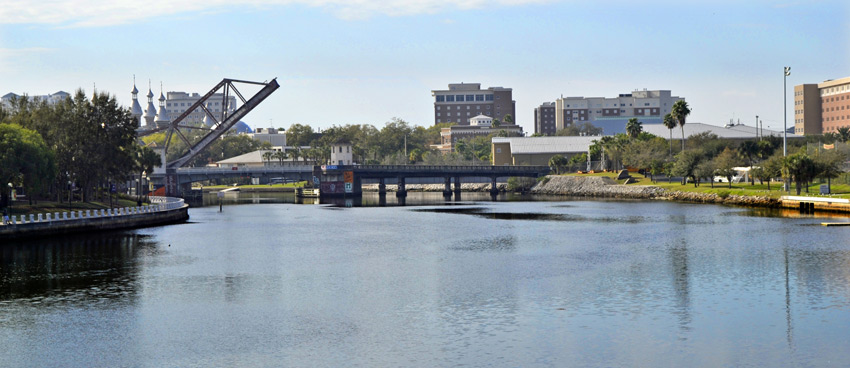
A view of the Cass St.
bridge and raised railroad bridge, looking south from the
Laurel St. bridge
|













